The first thing to do upon entering Christy’s Art Center in Sag Harbor to see the fantastic and important exhibition pairing Larry Rivers and Nathan Slate Joseph is to ask for Julie Keyes. The veteran curator, organizer of the exhibition, and close friend of both artists can provide a history lesson of such vivid intimacy that no book or documentary film could compare.
The show is titled “Late Night Conversations,” and Keyes is clearly a part of the dialogue, along with an unspoken third figure, the late John Chamberlain (1927-2011), whose presence I felt throughout the three packed rooms of significant sculpture, painting, relief and drawings. Included in the show are many works that play a crucial, behind-the-scenes role in the creation of what are now considered to be masterpieces of the art of our time.
Without Keyes as my guide I might have walked right by Iron Maiden, which stares aloofly toward the front door with that distant attitude of so many of Rivers’s figural works. I was on my way to see the artist’s David Smith-like Figure and Bird Trophy, glowing red in the shadows just beyond. But then I learned that Iron Maiden was assembled in 1957 (two years before Figure and Bird Trophy) from the fender of a Ford, its grey-blue body also providing the materials for Chamberlain’s very first sculpture made from automobile steel, which should give any serious student of contemporary art pause.
.
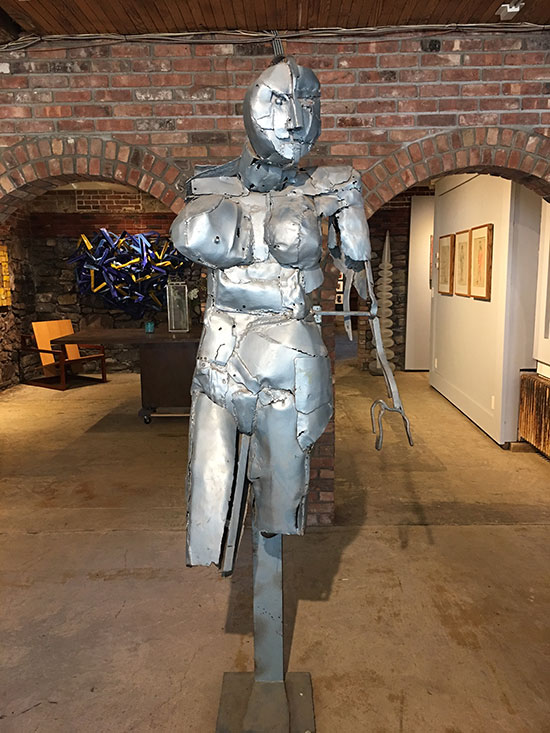
"Iron Maiden (Ford Fender" by Larry Rivers, 1957. 80 1/4 x 29 1/2 x 20 inches. Courtesy of Julie Keyes.
.
As unofficial mentor to Joseph, Larry Rivers (1923-2002) is due pride of place. His improbably dramatic life began when he was born Yitzroch Loiza Grossberg in the Bronx in 1923. His first incarnation was as a jazz saxophone player (he changed his name when the band was introduced as “Larry Rivers and the Mudcats” at a New York club). After serving in the army he studied at Juilliard, and befriended Miles Davis and Charlie Parker.
A close encounter with a Braque painting in 1945 led to an abrupt turn toward painting, and he studied under Hans Hofmann and William Baziotes. His first one-man show, at the Jane Street Gallery, was in 1949, but it was Washington Crossing the Delaware, completed in1953 and now on view at the Whitney that ferried him to fame.
A highlight of the Christy’s Art Center show for those who know the canonic Rivers works at the Metropolitan Museum, MoMA and the Whitney is a group of four “fast” drawings of Berdie Burger, preparatory studies for the major double portrait of her that is in the Whitney. Berdie was the artist’s mother-in-law. After her daughter left him with the children, Berdie agreed to pose, essentially (according to the redoubtable Keyes) in order to help out with the family finances.
.
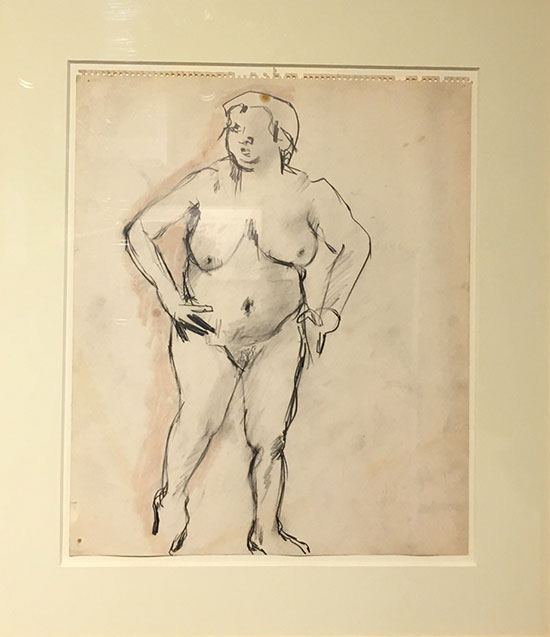
"Fast Berdie Drawing" by Larry Rivers, 1954. Pencil on Paper, 16 3/4 x 13 7/8 inches. Courtesy of Julie Keyes.
.
Because of the connection between these drawings and the classic painting, they demand attention, rewarded amply by the insight they offer into his draughtsmanship and figural technique, swiftly traced in pencil and accented with colored pencil or pastel.
In addition to his impressive musical background, Rivers was known to collaborate with such writers as Kenneth Koch, John Ashbery, Frank O’Hara, Allen Ginsberg, Gregory Corso and Jack Kerouac, with whom he made a film. The literary revelation in this show, though, looks back to the Tang dynasty in China and the erotic poetry of the supreme master of the short lyric, Li Bai (701-762), sometimes transliterated in the Wade-Giles, as by Rivers in his painting, as Li Po.
The three huge and relatively (for Rivers) tight figural paintings in a style that is reminiscent of the murals of Dunhuang as well as 20th century Chinese painters such as Qi Bai Shi are among the dramatic highlights of the show. According to Keyes, they have never been seen before. While Rivers inscribes his own favorite poem by Li Bai in the lower left corner of one of these three, I was reminded of another superb piece he wrote, “An Encounter in the Field,” the sort of naughty scene that, along with calling the emperor’s curvy courtesan Yang Guai Fei a minx, got the poet kicked out of court. It reads in full:
Came an amorous rider,
Trampling the fallen flowers of the road.
The dangling end of his crop
Brushes a passing carriage of five-colored clouds.
The jeweled curtain is raised,
A beautiful woman smiles within—
“That is my house,” she whispers,
Pointing to a pink house beyond.
.
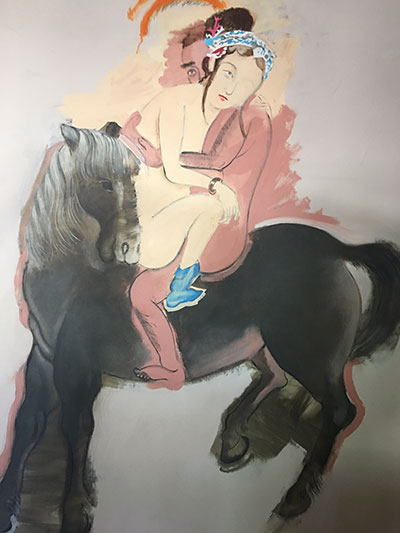
"Erotic Art II: Cantor" by Larry Rivers, 1980. Oil on canvas, 74 1/4 x 60 1/4 inches. Courtesy of Julie Keyes.
.
Rivers once said of his protege Nathan Slate Joseph: “There’s a kind of weight and primitive attractiveness to the work. It’s attention-getting. He’s got something going, and I really think it’s good.”
Joseph studied at Pratt and the Art Students League, and showed at Ivan Karp’s gallery OK Harris in Soho, where he lived for many years. The luminous steel plate compositions that are the energetic core of this show trace their genesis to a pivotal trip he took to Mexico’s Pacific coast in 1975 to visit Rivers at his studio in Zihuatanejo.
The sheer optical power of the bright blues, yellows and reds he saw on the buildings, (which reminded him of buildings in his childhood in the coastal town Rishon Le-Zion, where he was born in 1943), led him to acquire some of the powdered pigment the Mexicans used, which he mixed with acid and water and applied with a big scrub brush to galvanized steel, working outdoors in his Sagaponack studio’s garden. Brimming with incidents and accidents, the dynamic excitement of those powdered pigments bloomed into life on the wet steel. Fixed in permanent monumental form—with the many blues of Blue Silence showing the range of a Chagall watercolor—these hues are “completed” by nature itself, as Joseph is utterly and boldly comfortable leaving them out in the elements to gain their patina.
.

"Blue Silence" by Nathan Slate Joseph, 2006. Pure pigment, steel, 48 x 72 x 2 inches. Courtesy of Julie Keyes.
.
Joseph’s close connection with Chamberlain is most explicit in Woogiwoogione, a frantic wall relief of pigmented steel that buzzes on the brickwork of the Christy’s Art Center space. The heavyweight in the show is Macchu Picchu, a tall vertical work that summons, in a way that suggests the rectangular manipulations of Hofmann, an epic trove of gold, bronze and steel in all those metals’ many textural glories.
.
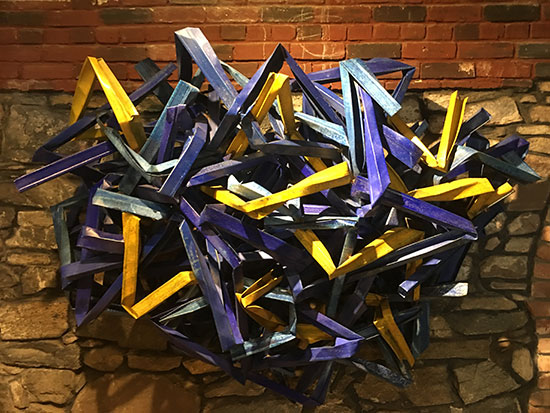
"Woogiwoogione" by Nathan Slate Joseph, 2013. Pure pigment, steel, 61 x 72 x 2 inches. Courtesy of Julie Keyes.
.
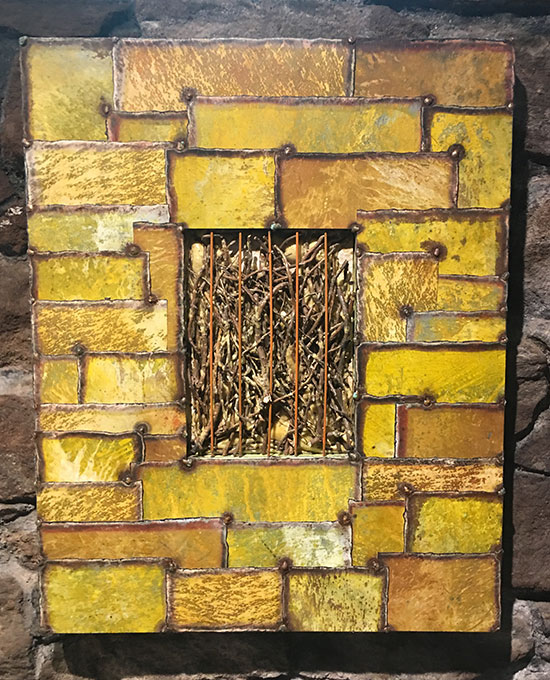
"Macchu Picchu" by Nathan Slate Joseph. Pure pigment, steel, 72 x 36 x 2 inches. Courtesy of Julie Keyes.
.
______________________________
BASIC FACTS: “Larry Rivers and Nathan Slate Joseph: Late Night Conversations” is on view June 10 to July 10, 2017 at Christy’s Art Center, 3 Madison Street, Sag Harbor, NY 11963. www.juliekeyesart.com
______________________________
Copyright 2017 Hamptons Art Hub LLC. All rights reserved.
